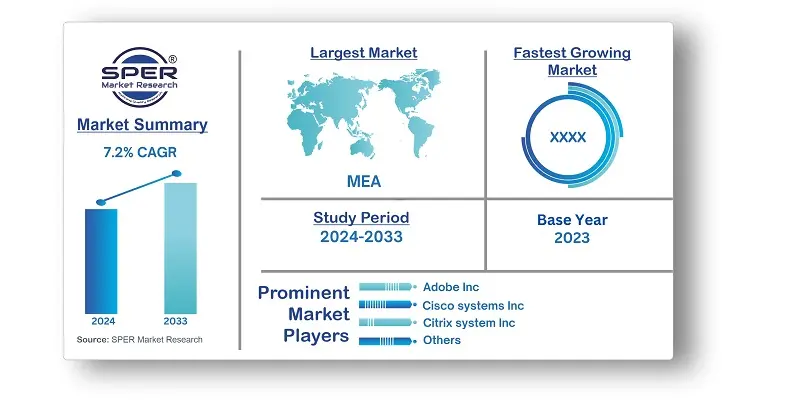
Middle East and Africa E-Learning Market Growth, Size, Trends, Share, Demand and Future Outlook
Middle East and Africa E-Learning Market Size- By Delivery Mode, By Learning Mode, By End User- Regional Outlook, Competitive Strategies and Segment Forecast to 2033
| Published: Mar-2024 | Report ID: EDUI2401 | Pages: 1 - 152 | Formats*: |
| Category : Education Industry | |||
- February 2022: The Saudi government promotes e-learning programmes to improve education quality. For example, in February 2022, the Ministry of Education and the Saudi Electronic University hosted a forum in Riyadh to discuss the future of learning and technology. The forum was founded to promote the use of e-learning methodologies and technologies in MEA nations' educational systems. Furthermore, several additional institutions are launching projects to implement e-learning portals, increasing demand for e-learning solutions and fueling the Middle East and Africa e-learning market growth.


| Report Metric | Details |
| Market size available for years | 2020-2033 |
| Base year considered | 2023 |
| Forecast period | 2024-2033 |
| Segments covered | By Delivery Mode, By Learning Mode, By End User |
| Regions covered | Saudi Arabia, South Africa, The UAE, Rest of Middle East & Africa |
| Companies Covered | Adobe Inc., Cisco systems Inc., Citrix system Inc., Docebo Inc., Gp Strategies Corporation, Oracle corporation, Pearson plc, Skillsoft Corporation, Others |
- Educational Institutions
- Educational Technology Providers
- Teachers and Instructors
- Students and Learners
- Parents
- Human Resource Professionals
- Training and Development Consultants
- Others
| By Delivery Mode: |
|
| By Learning Mode: |
|
| By End User: |
|
- Middle East & Africa E-Learning Market Size (FY’2024-FY’2033)
- Overview of Middle East & Africa E-Learning Market
- Segmentation of Middle East & Africa E-Learning Market By Delivery Mode (LMS, Mobile, Online, Others)
- Segmentation of Middle East & Africa E-Learning Market By Learning Mode (Instructor-Led, Self-Paced)
- Segmentation of Middle East & Africa E-Learning Market By End User (Academic, Corporate)
- Statistical Snap of Middle East & Africa E-Learning Market
- Expansion Analysis of Middle East & Africa E-Learning Market
- Problems and Obstacles in Middle East & Africa E-Learning Market
- Competitive Landscape in the Middle East & Africa E-Learning Market
- Impact of COVID-19 and Demonetization on Middle East & Africa E-Learning Market
- Details on Current Investment in Middle East & Africa E-Learning Market
- Competitive Analysis of Middle East & Africa E-Learning Market
- Prominent Players in the Middle East & Africa E-Learning Market
- SWOT Analysis of Middle East & Africa E-Learning Market
- Middle East & Africa E-Learning Market Future Outlook and Projections (FY’2024-FY’2033)
- Recommendations from Analyst
1.1. Scope of the report1.2. Market segment analysis
2.1. Research data source2.1.1. Secondary Data2.1.2. Primary Data2.1.3. SPER’s internal database2.1.4. Premium insight from KOL’s2.2. Market size estimation2.2.1. Top-down and Bottom-up approach2.3. Data triangulation
4.1. Driver, Restraint, Opportunity and Challenges analysis4.1.1. Drivers4.1.2. Restraints4.1.3. Opportunities4.1.4. Challenges4.2. COVID-19 Impacts of the Middle East & Africa E-Learning Market
5.1. SWOT Analysis5.1.1. Strengths5.1.2. Weaknesses5.1.3. Opportunities5.1.4. Threats5.2. PESTEL Analysis5.2.1. Political Landscape5.2.2. Economic Landscape5.2.3. Social Landscape5.2.4. Technological Landscape5.2.5. Environmental Landscape5.2.6. Legal Landscape5.3. PORTER’s Five Forces5.3.1. Bargaining power of suppliers5.3.2. Bargaining power of buyers5.3.3. Threat of Substitute5.3.4. Threat of new entrant5.3.5. Competitive rivalry5.4. Heat Map Analysis
6.1. Middle East & Africa E-Learning Market Manufacturing Base Distribution, Sales Area, Product Type6.2. Mergers & Acquisitions, Partnerships, Product Launch, and Collaboration in Middle East & Africa E-Learning Market
7.1. Middle East & Africa E-Learning Market Value Share and Forecast, By Delivery Mode, 2024-20337.2. LMS7.3. Mobile7.4. Online7.5. Others
8.1. Middle East & Africa E-Learning Market Value Share and Forecast, By Learning Mode, 2024-20338.2. Instructor-Led8.3. Self-Paced
9.1. Middle East & Africa E-Learning Market Value Share and Forecast, By End User, 2024-20339.2. Academic9.2.1. K-129.2.2. Higher Institution9.3. Corporate
10.1. Middle East & Africa E-Learning Market Size and Market Share
11.1. Middle East & Africa E-Learning Market Size and Market Share By Delivery Mode (2020-2027)11.2. Middle East & Africa E-Learning Market Size and Market Share By Delivery Mode (2028-2033)
12.1. Middle East & Africa E-Learning Market Size and Market Share By Learning Mode (2020-2026)12.2. Middle East & Africa E-Learning Market Size and Market Share By Learning Mode (2027-2033)
13.1. Middle East & Africa E-Learning Market Size and Market Share By End User (2020-2026)13.2. Middle East & Africa E-Learning Market Size and Market Share By End User (2027-2033)
14.1. Middle East & Africa E-Learning Market Size and Market Share By Region (2020-2026)14.2. Middle East & Africa E-Learning Market Size and Market Share By Region (2027-2033)14.3. Saudi Arabia14.4. South Africa14.5. The UAE14.6. Rest of Middle East & Africa
15.1. Adobe Inc.15.1.1. Company details15.1.2. Financial outlook15.1.3. Product summary15.1.4. Recent developments15.2. Cisco Systems Inc.15.2.1. Company details15.2.2. Financial outlook15.2.3. Product summary15.2.4. Recent developments15.3. Citrix Systems Inc.15.3.1. Company details15.3.2. Financial outlook15.3.3. Product summary15.3.4. Recent developments15.4. Cornerstone OnDemand Inc.15.4.1. Company details15.4.2. Financial outlook15.4.3. Product summary15.4.4. Recent developments15.5. Docebo Inc.15.5.1. Company details15.5.2. Financial outlook15.5.3. Product summary15.5.4. Recent developments15.6. Gp Strategies Corporation15.6.1. Company details15.6.2. Financial outlook15.6.3. Product summary15.6.4. Recent developments15.7. Oracle corporation15.7.1. Company details15.7.2. Financial outlook15.7.3. Product summary15.7.4. Recent developments15.8. Pearson plc15.8.1. Company details15.8.2. Financial outlook15.8.3. Product summary15.8.4. Recent developments15.9. SAP SE15.9.1. Company details15.9.2. Financial outlook15.9.3. Product summary15.9.4. Recent developments15.10. Skillsoft Corporation15.10.1. Company details15.10.2. Financial outlook15.10.3. Product summary15.10.4. Recent developments15.11. Others
SPER Market Research’s methodology uses great emphasis on primary research to ensure that the market intelligence insights are up to date, reliable and accurate. Primary interviews are done with players involved in each phase of a supply chain to analyze the market forecasting. The secondary research method is used to help you fully understand how the future markets and the spending patterns look likes.
The report is based on in-depth qualitative and quantitative analysis of the Product Market. The quantitative analysis involves the application of various projection and sampling techniques. The qualitative analysis involves primary interviews, surveys, and vendor briefings. The data gathered as a result of these processes are validated through experts opinion. Our research methodology entails an ideal mixture of primary and secondary initiatives.



Frequently Asked Questions About This Report
PLACE AN ORDER
Year End Discount
Sample Report
Pre-Purchase Inquiry
NEED CUSTOMIZATION?
Request CustomizationCALL OR EMAIL US
100% Secure Payment






Related Reports
Our Global Clients
Our data-driven insights have influenced the strategy of 200+ reputed companies across the globe.






















